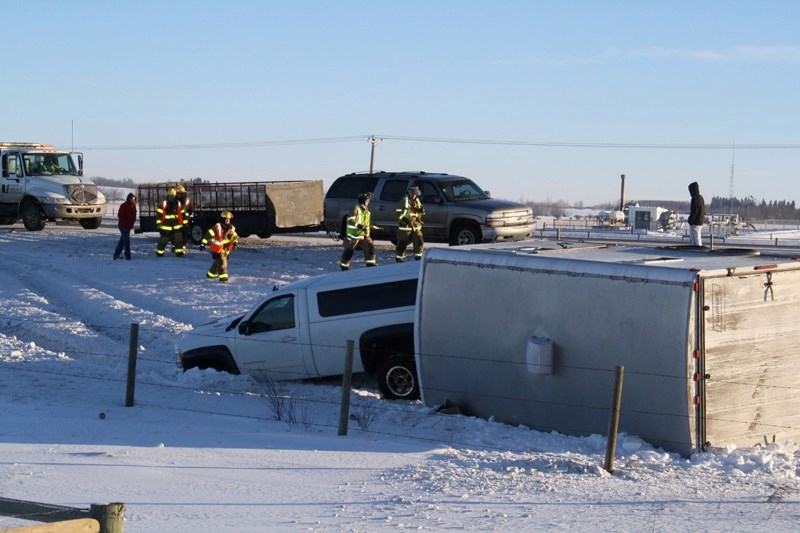When it comes to slowing down for emergency crews working on West Central Alberta highways, too many people still aren't getting the message, say officials.
According to the current provincial law, when any emergency crew (including EMS, police, fire crews and tow trucks) are working, vehicles driving in the adjacent lane must slow down to a maximum of 60 km/h on a highway or thoroughfare.
Cpl. Clint Gulash of the Didsbury RCMP said that the fact he is an RCMP officer hasn't stopped some people from blowing past him while he's been at an emergency scene.
When a few semi-trucks jack-knifed on the QEII during a recent snowstorm, Gulash ended up standing in the ditch while emergency crews towed the trucks out of the ditch.
“I had people coming up so fast on me, I was actually getting quite nervous that I was going to get hit,” said Gulash.
He was in a police truck, with all the lights on, another officer in another nearby patrol car had her lights on, and the tow truck at the scene also had its lights flashing, but drivers were still driving by at highway speeds, he noted.
“You need to adjust your speed according to road conditions and for unknowns that are going to be coming up,” he said. “Slowing down to a speed at which you can react to whatever it is, is the most prudent way to drive safely.”
He believes many drivers are either unsure or unaware of the law and may be thinking that the adjacent lane stipulation is confusing, which may contribute to the problem.
From a policing perspective, Gulash believes it would simplify the issue to just make a standard law that everybody in all lanes travelling in one direction has to slow down to 60 km/h when emergency crews are present, he said.
“Slowing down is just a prudent thing to do. You don't know what the road is going to be like ahead. You need to adjust your speed accordingly,” he said.
Stuart Brideaux, public education officer for Calgary zone EMS, said that drivers speeding by accident scenes is certainly a concern for him and his colleagues, especially on highways.
“Common sense would dictate that traffic in the vicinity at all should slow down and concentrate on their driving to make sure they're not creating another hazard while first responders work,” said Brideaux.
“I know that likely – let's say within the Calgary zone - probably every single day, in the zone somewhere, our crews - whether in the city or rural environment - are contending with drivers that don't slow down.”
The biggest message everyone needs to get is that motorists need to be aware that EMS and police are at work when they are on the side of the road, he stated.
“It's by no means our intention to cause a disruption or to slow down traffic, but that inevitably happens,” he said. “That's our job site.
“You never know who the patient could be - it could be your friend or family or a loved one. You never know who we're working on, right?”
Kyle Leeson, secretary and treasurer for the Didsbury Fire Department, said that the department usually parks its tanker truck in front of the scene, prepared for the worst-case scenario.
“It carries a whole lot of water, weighs a lot, and it is our oldest truck right now, so if it does get smashed into, it's not a huge loss,” said Leeson.
He and his fellow firefighters have been trained in many aspects of safety, including working safely at crash scenes.
“Because people aren't slowing down, you always have a set of eyes watching the traffic - whether for people not slowing down or people losing control and plowing into you,” he said.
Drivers often slow down when police are on the scene because of the colour of their red and blue lights, whereas emergency services and tow trucks use amber, yellow, and white, he said.
“They're not getting in trouble. Unless it's their emergency, they have no need to slow down for us,” he noted.
He thinks another reason people aren't slowing down is simply because of tunnel vision, he added.
“(They don't slow down) until it's right in front of their face and then they realize it's too late - then they just keep going,” he said.
“We put out signs to slow down. They think they've slowed down enough, but nowhere near what we'd like them to.”
During storms or while working on icy roads, sometimes it is necessary to completely shut down a highway, he noted.



